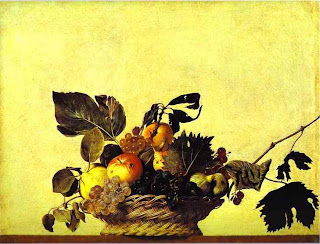A friend sent me an email last night praising Caravaggio's mastery of facial expression and asking what I knew about his methods. I'm no art historian and I'm one of the worst visual artists alive, but I have done some reading about what experts have discovered regarding Caravaggio's approach to the canvas.
During his early years in northern Italy he learned to paint faces and still lifes. Many of his first works in Rome explored these subjects. Here are "Boy with a Basket of Fruit," "Boy Bitten by a Lizard," and "Still Life with a Basket of Fruit."
Notice that the fruit in the first painting is so ripe, or over-ripe, that it's bursting open, which makes the portrait even more sensual. In the third painting, the produce is past its prime -- the leaves are withered, there's a worm-hole in the apple, and the pear should be eaten immediately.
Part of Caravaggio's appeal is that he didn't idealize, even in his later religious works. It was especially controversial when he used prostitutes as models for Saint Catherine of Alexandria or the Virgin Mary, as in "Madonna of Loreto" below.
Here's what Helen Langdon, who wrote the best biography of Caravaggio, has to say about this painting: "Caravaggio's Madonna is warmly human, and brought close to the pilgrims, who are separated from her by only a step.... And yet we are aware that she is a vision; she is lit from above, and towers over the pilgrims, her size, as in medieval art, conveying transcendence, and her strange, weightless pose suggesting that she has just alighted in the doorway.... She is a deeply ambiguous figure, warm, fleshy (we feel the imprint of her fingers against the child's body), yet with an unreal grace, and encircled by mysterious light and shade. Caravaggio weaves together layers of reality and illusion; she is a housewife, welcoming the pilgrims in a dark Roman vicolo; she is a statue framed in a niche, suggesting the wooden statue within the shrine at Loreto, brought to warm life; she is truly the Madonna of Loreto, on the threshold of the Holy House, and born from the faith and in the imagination of the pilgrims."
But the simplicity of the Virgin and child, and especially the dirty feet of the pilgrims, outraged many of Caravaggio's contemporaries. It was rare to paint religious works in which the figures were depicted as being so human. Here's a little more from Langdon: "It was entirely new for the humble poor to appear centre stage in a public altarpiece, and the people 'made a great fuss over it.' Cardinal Paleotti had written that the naturalism of religious art should not shock or disturb, and perhaps the people missed a more consoling and traditional splendour. The picture shows no hint of the squalor in which the Roman poor truly lived. Yet at a deep level it is in harmony with Oratorian spirituality, thrusting the poor, and their simple faith, before a courtly elite, insisting on a low style, and moving the viewer to that love and compassion through which he might win salvation."
As for Caravaggio's methods, there are a few interesting facts and theories. Scientific testing has discovered that he didn't draw or sketch on his canvases; he just went straight in with the paintbrush. And many experts now believe that he used mirrors in the studio, and maybe even worked with a camera obscura to project images onto the canvas. The best argument for his use of these techniques is that a disproportionate number of his figures appear to be left-handed.
I'm sure I've failed at answering the original question, but there you have it.
Yesterday, when I tracked down the address of Fillide Melandroni, Caravaggio's beloved courtesan, I discovered that her street is now the poshest shopping strip in Rome. Designer stores flank the avenue as it pours into the Piazza di Spagna. I leaned against a storefront, avoiding the masses with their fistfuls of purchases, and tried to imagine Caravaggio strolling up Via Condotti towards Fillide's house, looking up at her window to see if she was alone or otherwise engaged. In front of me, they were setting up a photo shoot to advertise a new line of handbags. You can see the model below enjoying a cigarette break.





No comments:
Post a Comment